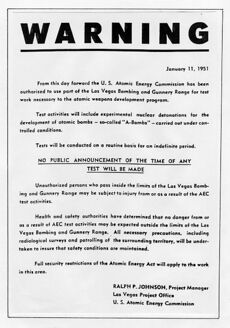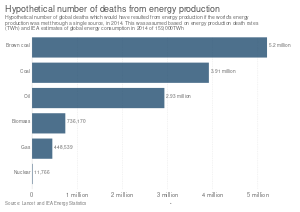الحوادث والأحداث النووية والإشعاعية

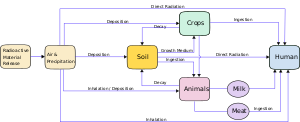

A nuclear and radiation accident is defined by the International Atomic Energy Agency (IAEA) as "an event that has led to significant consequences to people, the environment or the facility. Examples include lethal effects to individuals, large radioactivity release to the environment, reactor core melt."[6] The prime example of a "major nuclear accident" is one in which a reactor core is damaged and significant amounts of radioactive isotopes are released, such as in the Chernobyl disaster in 1986 and Fukushima nuclear disaster in 2011.[7]
The impact of nuclear accidents has been a topic of debate since the first nuclear reactors were constructed in 1954 and has been a key factor in public concern about nuclear facilities.[8] Technical measures to reduce the risk of accidents or to minimize the amount of radioactivity released to the environment have been adopted, however human error remains, and "there have been many accidents with varying impacts as well near misses and incidents".[8][9] As of 2014, there have been more than 100 serious nuclear accidents and incidents from the use of nuclear power. Fifty-seven accidents or severe incidents have occurred since the Chernobyl disaster, and about 60% of all nuclear-related accidents/severe incidents have occurred in the USA.[10] Serious nuclear power plant accidents include the Fukushima nuclear disaster (2011), the Chernobyl disaster (1986), the Three Mile Island accident (1979), and the SL-1 accident (1961).[11] Nuclear power accidents can involve loss of life and large monetary costs for remediation work.[12]
Nuclear submarine accidents include the K-19 (1961), K-11 (1965), K-27 (1968), K-140 (1968), K-429 (1970), K-222 (1980), and K-431 (1985)[11][13][14] accidents. Serious radiation incidents/accidents include the Kyshtym disaster, the Windscale fire, the radiotherapy accident in Costa Rica,[15] the radiotherapy accident in Zaragoza,[16] the radiation accident in Morocco,[17] the Goiania accident,[18] the radiation accident in Mexico City, the radiotherapy unit accident in Thailand,[19] and the Mayapuri radiological accident in India.[19]
The IAEA maintains a website reporting recent nuclear accidents.[20]
. . . . . . . . . . . . . . . . . . . . . . . . . . . . . . . . . . . . . . . . . . . . . . . . . . . . . . . . . . . . . . . . . . . . . . . . . . . . . . . . . . . . . . . . . . . . . . . . . . . . . . . . . . . . . . . . . . . . . . . . . . . . . . . . . . . . . . . . . . . . . . . . . . . . . . . . . . . . . . . . . . . . . . . .
حوادث المحطات النووية

قائمة حوادث وأحداث المحطات النووية
| Date | Location of accident | Description of accident or incident | Dead | Cost ($US millions 2006) |
INES level[23] |
|---|---|---|---|---|---|
| September 29, 1957 | Mayak, Kyshtym, Soviet Union | The Kyshtym disaster was a radiation contamination accident (after a chemical explosion that occurred within a storage tank) at Mayak, a Nuclear fuel reprocessing plant in the Soviet Union. | Estimated 200 possible cancer fatalities[24] | 6 | |
| October 10, 1957 | Sellafield, Cumberland, United Kingdom | Windscale fire was a fire at the British atomic bomb project (in a plutonium-production-reactor) damaged the core and released an estimated 740 terabecquerels of iodine-131 into the environment. A rudimentary smoke filter constructed over the main outlet chimney successfully prevented a far worse radiation leak. | 0 direct, estimated up to 240 possible cancer victims[24] | 5 | |
| January 3, 1961 | Idaho Falls, Idaho, United States | Explosion at SL-1 prototype at the National Reactor Testing Station. All 3 operators were killed when a control rod was removed too far. | 3 | 22 | 4 |
| October 5, 1966 | Frenchtown Charter Township, Michigan, United States | Meltdown of some fuel elements in the Fermi 1 Reactor at the Enrico Fermi Nuclear Generating Station. Little radiation leakage into the environment. | 0 | 132[25] | 4 |
| January 21, 1969 | Lucens reactor, Vaud, Switzerland | On January 21, 1969, it suffered a loss-of-coolant accident, leading to meltdown of one fuel element and radioactive contamination of the cavern, which before was sealed. | 0 | 4 | |
| December 7, 1975 | Greifswald, East Germany | Electrical error in Greifswald Nuclear Power Plant causes fire in the main trough that destroys control lines and five main coolant pumps | 0 | 443 | 3 |
| January 5, 1976 | Jaslovské Bohunice, Czechoslovakia | Malfunction during fuel replacement. Fuel rod ejected from reactor into the reactor hall by coolant (CO2).[26] | 2 | 1,700 | 4 |
| March 28, 1979 | Three Mile Island, Pennsylvania, United States | Loss of coolant and partial core meltdown due to operator errors and technical flaws. There is a small release of radioactive gases. See also Three Mile Island accident health effects. | 0 | 2,400 | 5 |
| September 15, 1984 | Athens, Alabama, United States | Safety violations, operator error and design problems force a six-year outage at Browns Ferry Unit 2. | 0 | 110 | |
| March 9, 1985 | Athens, Alabama, United States | Instrumentation systems malfunction during startup, which led to suspension of operations at all three Browns Ferry Units | 0 | 1,830 | |
| April 11, 1986 | Plymouth, Massachusetts, United States | Recurring equipment problems force emergency shutdown of Boston Edison's Pilgrim Nuclear Power Plant | 0 | 1,001 | |
| April 26, 1986 | Chernobyl, Chernobyl Raion (Now Ivankiv Raion), Kiev Oblast, Ukraininan SSR, Soviet Union | A flawed reactor design and inadequate safety procedures led to a power surge that damaged the fuel rods of reactor no. 4 of the Chernobyl power plant. This caused an explosion and meltdown, necessitating the evacuation of 300,000 people and dispersing radioactive material across Europe (see Effects of the Chernobyl disaster).
Around 5% (5200 PBq) of the core was released into the atmosphere and downwind. |
28 direct, 19 not entirely related and 15 children due to thyroid cancer, as of 2008.[27][28] Estimated up to 4,000 possible cancer deaths.[29] | 6,700 | 7 |
| May 4, 1986 | Hamm-Uentrop, West Germany | Experimental THTR-300 reactor releases small amounts of fission products (0.1 GBq Co-60, Cs-137, Pa-233) to surrounding area | 0 | 267 | |
| December 9, 1986 | Surry, Virginia, United States | Feedwater pipe break at Surry Nuclear Power Plant kills 4 workers | 4 | ||
| March 31, 1987 | Delta, Pennsylvania, United States | Peach Bottom units 2 and 3 shutdown due to cooling malfunctions and unexplained equipment problems | 0 | 400 | |
| December 19, 1987 | Lycoming, New York, United States | Malfunctions force Niagara Mohawk Power Corporation to shut down Nine Mile Point Unit 1 | 0 | 150 | |
| March 17, 1989 | Lusby, Maryland, United States | Inspections at Calvert Cliff Units 1 and 2 reveal cracks at pressurized heater sleeves, forcing extended shutdowns | 0 | 120 | |
| October 19, 1989 | Vandellòs, Spain | A fire damaged the cooling system in unit 1 of the Vandellòs nuclear power plant, getting the core close to meltdown. The cooling system was restored before the meltdown but the unit had to be shut down due to the elevated cost of the repair. | 0 | 220[30] | 3 |
| March 1992 | Sosnovyi Bor, Leningrad Oblast, Russia | An accident at the Sosnovy Bor nuclear plant leaked radioactive iodine into the air through a ruptured fuel channel. | |||
| February 20, 1996 | Waterford, Connecticut, United States | Leaking valve forces shutdown Millstone Nuclear Power Plant Units 1 and 2, multiple equipment failures found | 0 | 254 | |
| September 2, 1996 | Crystal River, Florida, United States | Balance-of-plant equipment malfunction forces shutdown and extensive repairs at Crystal River Unit 3 | 0 | 384 | |
| September 30, 1999 | Ibaraki Prefecture, Japan | Tokaimura nuclear accident killed two workers, and exposed one more to radiation levels above permissible limits. | 2 | 54 | 4 |
| February 16, 2002 | Oak Harbor, Ohio, United States | Severe corrosion of reactor vessel head forces 24-month outage of Davis-Besse reactor | 0 | 143 | 3 |
| April 10, 2003 | Paks, Hungary | Collapse of fuel rods at Paks Nuclear Power Plant unit 2 during its corrosion cleaning led to leakage of radioactive gases. It remained inactive for 18 months. | 0 | 3 | |
| August 9, 2004 | Fukui Prefecture, Japan | Steam explosion at Mihama Nuclear Power Plant kills 4 workers and injures 7 more | 4 | 9 | 1 |
| July 25, 2006 | Forsmark, Sweden | An electrical fault at Forsmark Nuclear Power Plant caused multiple failures in safety systems that had the reactor to cool down | 0 | 100 | 2 |
| March 11, 2011 | Fukushima, Japan | A tsunami flooded and damaged the plant's 3 active reactors, drowning two workers. Loss of backup electrical power led to overheating, meltdowns, and evacuations.[31] One man died suddenly while carrying equipment during the clean-up.[32] The plant's reactors Nr. 4, 5 and 6 were inactive at the time. | 1[33] and 3+ labour accidents; plus a broader number of primarily ill or elderly people from evacuation stress | 1,255–2,078 (2018 est.)[34] | 7 |
| September 12, 2011 | Marcoule, France | One person was killed and four injured, one seriously, in a blast at the Marcoule Nuclear Site. The explosion took place in a furnace used to melt metallic waste. | 1 |
الهجمات على المفاعلات النووية
الحوادث والأحداث الإشعاعية
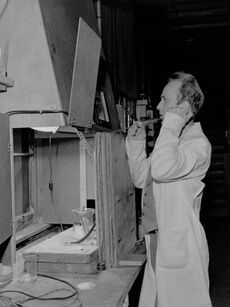



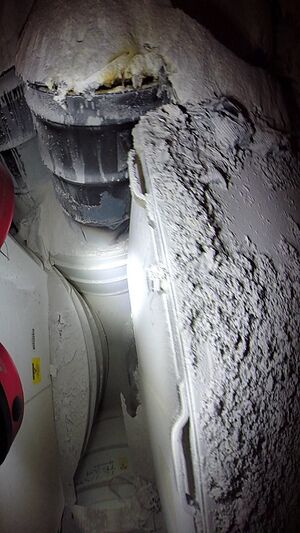
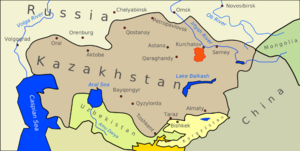
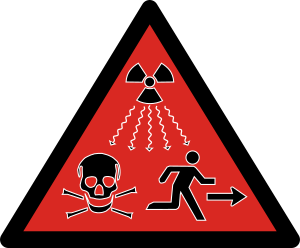
. . . . . . . . . . . . . . . . . . . . . . . . . . . . . . . . . . . . . . . . . . . . . . . . . . . . . . . . . . . . . . . . . . . . . . . . . . . . . . . . . . . . . . . . . . . . . . . . . . . . . . . . . . . . . . . . . . . . . . . . . . . . . . . . . . . . . . . . . . . . . . . . . . . . . . . . . . . . . . . . . . . . . . . .
ملخص اختبارات الأسلحة النووية حول العالم


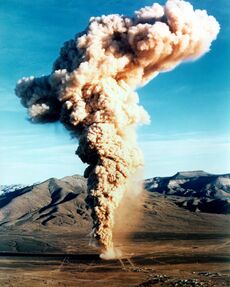
الإتجار والسرقات
تصنيف الحوادث
Nuclear meltdown
Criticality accidents
Decay heat
Transport

Equipment failure
Human error

Lost source
Comparisons
. . . . . . . . . . . . . . . . . . . . . . . . . . . . . . . . . . . . . . . . . . . . . . . . . . . . . . . . . . . . . . . . . . . . . . . . . . . . . . . . . . . . . . . . . . . . . . . . . . . . . . . . . . . . . . . . . . . . . . . . . . . . . . . . . . . . . . . . . . . . . . . . . . . . . . . . . . . . . . . . . . . . . . . .
Nuclear safety
Ecological impacts
Impact on land
Impact on water
Fukushima Daiichi accident
Chernobyl accident
Effects of acute radiation exposure
قالب:Whole-body absorbed dose symptom
See also
References
- ^ "SOURCES, EFFECTS AND RISKS OF IONIZING RADIATION : UNSCEAR 2013 Report" (PDF). Unscea.org. Retrieved 12 March 2019.
- ^ Richard Schiffman (12 March 2013). "Two years on, America hasn't learned lessons of Fukushima nuclear disaster". The Guardian.
- ^ Martin Fackler (June 1, 2011). "Report Finds Japan Underestimated Tsunami Danger". New York Times.
- ^ "Regulator OKs safety report on Kashiwazaki-Kariwa units - World Nuclear News". World-nuclear-news.org. Retrieved 12 March 2019.
- ^ "IAEA Team to Report on Kashiwazaki Kariwa Nuclear Power Plant Examination" (PDF). Iaea.org. Retrieved 12 March 2019.
- ^ Staff, IAEA, AEN/NEA. International Nuclear and Radiological Events Scale Users' Manual, 2008 Edition (PDF). Vienna, Austria: International Atomic Energy Agency. p. 183. Archived from the original (PDF) on May 15, 2011. Retrieved 2010-07-26.
{{cite book}}: CS1 maint: multiple names: authors list (link) - ^ Yablokov, Alexey V.; Nesterenko, Vassily B.; Nesterenko, Alexey; Sherman-Nevinger, consulting editor, Jannette D. (2009). Chernobyl: Consequences of the Catastrophe for People and the Environment. Boston, MA: Blackwell Publishing for the Annals of the New York Academy of Sciences. ISBN 978-1-57331-757-3. Retrieved 11 June 2016.
{{cite book}}:|last4=has generic name (help) - ^ أ ب M.V. Ramana. Nuclear Power: Economic, Safety, Health, and Environmental Issues of Near-Term Technologies, Annual Review of Environment and Resources, 2009, 34, p. 136.
- ^ Matthew Wald (February 29, 2012). "The Nuclear Ups and Downs of 2011". New York Times.
- ^ أ ب Sovacool, Benjamin K. (2010). "A Critical Evaluation of Nuclear Power and Renewable Electricity in Asia". Journal of Contemporary Asia. 40 (3): 369–400. doi:10.1080/00472331003798350. S2CID 154882872.
- ^ Gralla, Fabienne, Abson, David J., and Muller, Anders, P. et al. "Nuclear accidents call for transdisciplinary energy research", Sustainability Science, January 2015.
- ^ خطأ استشهاد: وسم
<ref>غير صحيح؛ لا نص تم توفيره للمراجع المسماةepe2011 - ^ Johnston, Robert (September 23, 2007). "Deadliest radiation accidents and other events causing radiation casualties". Database of Radiological Incidents and Related Events.
- ^ Gusev, Igor; Guskova, Angelina; Mettler, Fred A. (2001-03-28). Medical Management of Radiation Accidents, Second Edition (in الإنجليزية). CRC Press. ISBN 9781420037197.
- ^ Strengthening the Safety of Radiation Sources p. 15.
- ^ "NRC: Information Notice No. 85-57: Lost Iridium-192 Source Resulting in the Death of Eight Persons in Morocco". Nrc.gov.
- ^ The Radiological Accident in Goiania p. 2, Pub.iaea.org
- ^ أ ب Pallava Bagla. "Radiation Accident a 'Wake-Up Call' For India's Scientific Community" Science, Vol. 328, 7 May 2010, p. 679.
- ^ "IAEA Scientific and Technical Publications of Special Interest". Pub.iaea.org. Archived from the original on 2017-05-03. Retrieved 2016-04-07.
- ^ خطأ استشهاد: وسم
<ref>غير صحيح؛ لا نص تم توفيره للمراجع المسماةbksenpol - ^ Benjamin K. Sovacool (2009). The Accidental Century - Prominent Energy Accidents in the Last 100 Years Archived 2014-08-08 at the Wayback Machine
- ^ Timeline: Nuclear plant accidents BBC News, 11 July 2006.
- ^ أ ب Cohen, Jennie. "History's Worst Nuclear Disasters". HISTORY.
- ^ "Nuclear Accidents". Hyperphysics.phy-astr.gsu.edu.
- ^ cs:Havárie elektrárny Jaslovské Bohunice A-1
- ^ "Sources and effects of ionizing radiation—UNSCEAR 2008 Report. Volume II: EFFECTS. Scientific Annexes C, D and E" (PDF). UNSCEAR. 6 April 2011. pp. 64–65. Retrieved 23 March 2019.
- ^ "UNSCEAR assessments of the Chernobyl accident". Unscear.org. Retrieved 2016-10-19.
- ^ See in the referenced article List of nuclear power accidents by country, the official WHO-estimate
- ^ "La nit més llarga de Vandellòs". El País Catalunya. 18 October 2014.
- ^ "Worker dies at damaged Fukushima nuclear plant". CBS News. 2011-05-14.
- ^ "Fukushima Nuclear Accident Update Log". Iaea.org. 2011-04-11.
- ^ Rich, Motoko (Sep 6, 2018). "In a First, Japan Says Fukushima Radiation Caused Worker's Cancer Death (Published 2018)". The New York Times.
- ^ Jiji, Kyodo (March 24, 2018). "Estimated cost of Fukushima disaster might balloon to ¥218 billion". The Japan Times. Archived from the original on 2018-03-23. Retrieved 25 September 2018.
... balloon to between ¥131.8 billion and ¥218.2 billion.
{{cite news}}: CS1 maint: bot: original URL status unknown (link) – Based on the source's front page for 2018-03-24, the exchange rate was 105¥/USD, resulting in a range of USD1,255–2,078. - ^ Moss, William; Eckhardt, Roger (1995). "The Human Plutonium Injection Experiments" (PDF). Los Alamos Science. Radiation Protection and the Human Radiation Experiments (23): 177–223. Retrieved 13 November 2012.
- ^ "The Media & Me: [The Radiation Story No One Would Touch], Geoffrey Sea, Columbia Journalism Review, March/April 1994.
- ^ Cameron L. Tracy, Megan K. Dustin & Rodney C. Ewing, Policy: Reassess New Mexico's nuclear-waste repository, Nature, 13 January 2016.
- ^ Togzhan Kassenova (28 September 2009). "The lasting toll of Semipalatinsk's nuclear testing". Bulletin of the Atomic Scientists.
Further reading
- Chernobyl: Consequences of the Catastrophe for People and the Environment (2009)
- Chernobyl. Vengeance of peaceful atom. (2006)
- Conservation Fallout: Nuclear Protest at Diablo Canyon (2006)
- Contesting the Future of Nuclear Power (2011)
- Essence of Decision: Explaining the Cuban Missile Crisis (1971)
- Fallout: An American Nuclear Tragedy (2004)
- Fallout Protection (1961)
- Fukushima: Japan's Tsunami and the Inside Story of the Nuclear Meltdowns (2013)
- Full Body Burden: Growing Up in the Nuclear Shadow of Rocky Flats (2012)
- Hiroshima (1946)
- Killing Our Own: The Disaster of America’s Experience with Atomic Radiation (1982)
- In Mortal Hands: A Cautionary History of the Nuclear Age (2009)
- Making a Real Killing: Rocky Flats and the Nuclear West (1999)
- Maralinga: Australia’s Nuclear Waste Cover-up (2007)
- Non-Nuclear Futures: The Case for an Ethical Energy Strategy (1975)
- Normal Accidents: Living with High-Risk Technologies (1984)
- Nuclear or Not? Does Nuclear Power Have a Place in a Sustainable Energy Future? (2007)
- Nuclear Politics in America (1997)
- Nuclear Power and the Environment (1976)
- Nuclear Terrorism: The Ultimate Preventable Catastrophe (2004)
- Nuclear War Survival Skills (1979)
- Nuclear Weapons: The Road to Zero (1998)
- Nukespeak: Nuclear Language, Visions and Mindset (1982)
- On Nuclear Terrorism (2007)
- Plutopia (2013)
- The Limits of Safety (1993, Princeton University Press) by Scott Sagan
External links
- U.S. Nuclear Accidents (lutins.org) most comprehensive online list of incidents involving U.S. nuclear facilities and vessels, 1950–present
- US Nuclear Regulatory Commission (NRC) website with search function and electronic public reading room
- International Atomic Energy Agency website with extensive online library
- Plutopia: Nuclear Families, Atomic Cities, and the Great Soviet and American Plutonium Disasters
- Annotated bibliography for civilian nuclear accidents from the Alsos Digital Library for Nuclear Issues
قالب:Radiation poisoning قالب:Nuclear and radiation accidents and incidents
